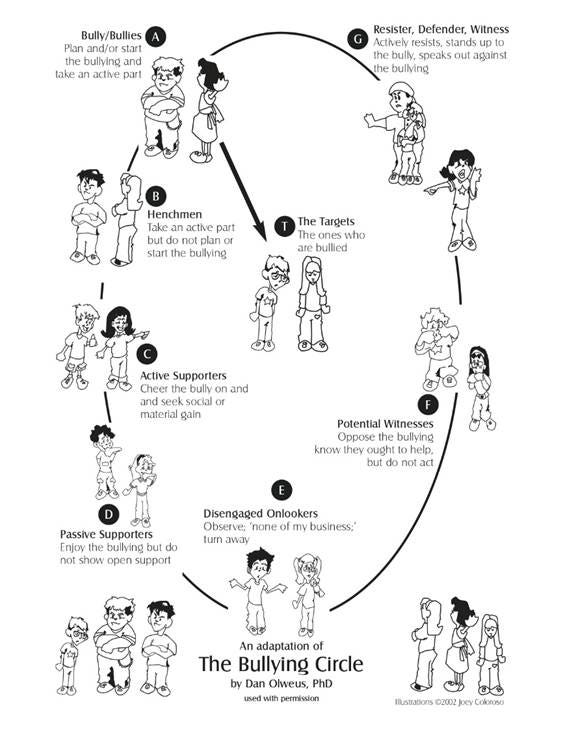The school bus camera begins to shake. Four seventh-graders lean across the bus aisle, hissing at 68-year-old bus monitor Karen Klein:
“You’re worthless.”
“Maybe your kids should kill themselves.”
Karen blinks hard, tears sliding behind her glasses. The rest of the bus stays silent; one student films. This is not a make-believe story. In 2012, a bunch of seventh graders bullied a 68-year-old bus monitor to tears. (Watch this gut-wrenching 3-minute video here.)
Once the video went viral online, the boys sent written apologies to Karen. The New York school district suspended them for a year, with senior-citizen service. An Indiegogo drive raised $700,000 for Karen, and she soon retired, earmarking $100,000 for an anti-bullying foundation.
Before we scroll down to forget the disturbing video, pause a moment and ask:
On the wrong day, with the wrong crowd cheering, could my child have slipped into those taunting seats too?
Eight Seats, One Decision
Psychologist Dan Olweus reminds us that bullying is a system, not a lone villain. The circle runs A through G. The image below captures the bullying cycle as visualised by Olweus:
The bullying circle begins with A, the bully who starts it all.
B and C encourage the bully on.
D and E hover at a distance- one enjoying the show, the other shrugging it off.
F knows it’s wrong yet stays silent.
Only G, the resister-defender, breaks the spell and says, “Stop.”
You can ask your teen, “Where were you the last time someone was picked on?” Naming the role that the child plays in such scenarios turns a foggy memory into a visible choice.
The ten-second break point
Studies show that when just one peer shifts to seat G- “Stop” -the bullying collapses within ten seconds in more than half of the cases. Silence props the show as it did in the case of Karen Klein.
However, a single nudge breaks the bullying cycle- unfortunately, there was no seventh grader in seat G when Karen Klein was bullied.
The two-ingredient recipe to stop bullying
Why doesn’t every child make the jump and say “Stop” to break the bullying cycle? Self-Determination Theory (SDT) offers a clue. As you may recall, we first explored SDT in an earlier post on moral identity.
As per SDT, teens act bravely when two needs are met:
Autonomy: “I have some say here.”
Relatedness: “Someone’s got my back.”
When these two needs remain unmet or muted, even a caring child decides to sit in the silent seat. Fill them, and the leap to seat G feels possible.
Every affirming positive nudge from the parent gives the teen a voice; every ritual that says “you belong” tops up the very fuel that makes upstanders possible. The science is clear: meeting the needs of autonomy and relatedness can often break the cycle, even in just ten seconds.
How courage adds seats at the table
Anthropologists say every society draws an invisible line around “people worth protecting.” They call it the Universe of Obligation. In a band of thirty, the circle is easy: kin, hunting partners, the baby who needs food.
As villages grow into towns, the circle widens to neighbours, then strangers who share a totem or a flag. Human progress is, in many ways, the story of that circle stretching- first to the next valley, then to people who pray differently, and finally to those we may never meet.
The takeaway for our children is that cruelty shrinks the circle, courage widens it. Every time someone speaks up for a weaker voice, they push the moral boundary a little farther, just as our ancestors once did around a flickering fire.
Coaching the seats your teen chooses
If one steady voice can crack a bullying circle in ten seconds, how do we raise kids who feel ready to be that voice?
The answer isn’t a single speech but the environment we build at home- one that fills their tanks of autonomy and belonging needs to the extent that being courageous feels possible.
Here are four everyday parenting steps that will help your teen choose seat G:
Map the circle, out loud.
Over dinner, try asking: “When Raj was teased today, which seat were you in:- instigator, silent watcher, helper?” Naming the seat shrinks shame and hands your teen the power to say “no” and break the bullying cycle.Watch the fuel gauge.
A teen who feels both tightly controlled and left out is running on an empty tank; that autonomy-plus-belonging gap is SDT’s blinking warning light. Low fuel breeds either lashing out or silent freezing, which manifests in bullying others or egging the bully in the team.Rehearse tiny courage.
Practice three-word lines with your kid while the stakes are low- “That’s not okay.” /“Sit with us.” /Need help?” Muscle memory prevails over moral lectures when adrenaline kicks in.Spend your praise wisely.
Bring the spotlight on the child who redirects a cruel group chat or sends a quiet DM of support, not just the one who scores in academic tests. Attention is currency; invest it where you want growth.
Every small cue you plant at home becomes the training ground for the ten-second courage your teen may need when they face or witness bullying.
Remember, raising kind isn’t always easy, but it’s always worth it. See you soon with the next issue of Raising Ki(n)d.
Gaurav G



